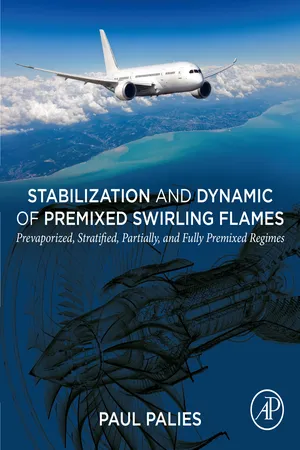
Stabilization and Dynamic of Premixed Swirling Flames
Prevaporized, Stratified, Partially, and Fully Premixed Regimes
- 400 pages
- English
- ePUB (mobile friendly)
- Available on iOS & Android
Stabilization and Dynamic of Premixed Swirling Flames
Prevaporized, Stratified, Partially, and Fully Premixed Regimes
About This Book
Stabilization and Dynamic of Premixed Swirling Flames: Prevaporized, Stratified, Partially, and Fully Premixed Regimes focuses on swirling flames in various premixed modes (stratified, partially, fully, prevaporized) for the combustor, and development and design of current and future swirl-stabilized combustion systems. This includes predicting capabilities, modeling of turbulent combustion, liquid fuel modeling, and a complete overview of stabilization of these flames in aeroengines. The book also discusses the effects of the operating envelope on upstream fresh gases and the subsequent impact of flame speed, combustion, and mixing, the theoretical framework for flame stabilization, and fully lean premixed injector design.
Specific attention is paid to ground gas turbine applications, and a comprehensive review of stabilization mechanisms for premixed, partially-premixed, and stratified premixed flames. The last chapter covers the design of a fully premixed injector for future jet engine applications.
- Features a complete view of the challenges at the intersection of swirling flame combustors, their requirements, and the physics of fluids at work
- Addresses the challenges of turbulent combustion modeling with numerical simulations
- Includes the presentation of the very latest numerical results and analyses of flashback, lean blowout, and combustion instabilities
- Covers the design of a fully premixed injector for future jet engine applications
Frequently asked questions
Information
The combustor
Abstract
Keywords
1 Overall principle of the gas turbine engine
1.1 Generalities and overall description
Table of contents
- Cover image
- Title page
- Table of Contents
- Copyright
- Dedication
- Preface
- Introduction
- 1: The combustor
- 2: Premixed combustion for combustors
- 3: Premixed swirling flame stabilization
- 4: Transient combustion
- 5: Swirling flame dynamics and combustion instability
- 6: Design and numerical simulation modeling
- 7: Lean fully premixed injector design
- Conclusion and perspectives
- References
- Index